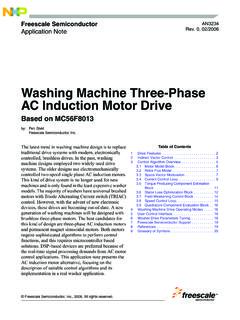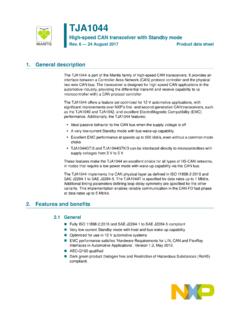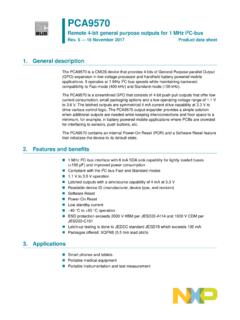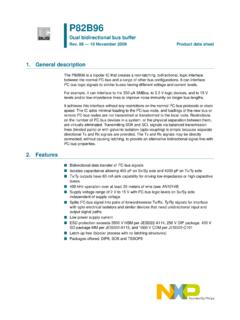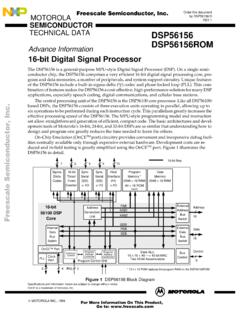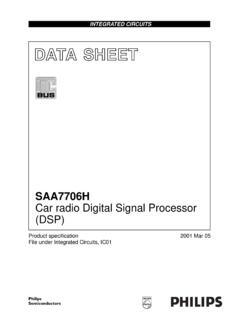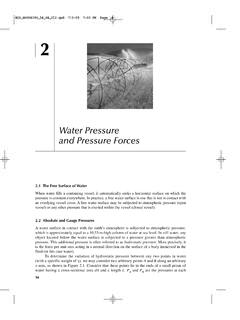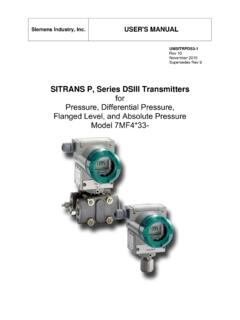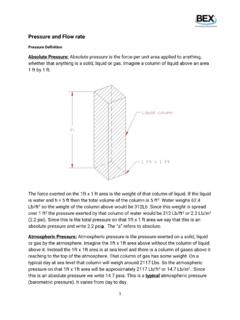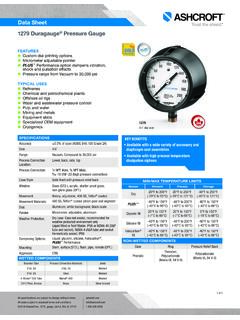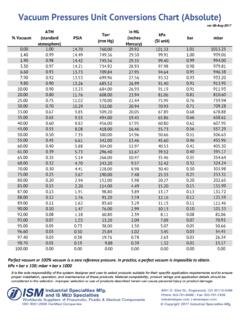Transcription of MPX10, 10 kPa Uncompensated Pressure Sensors-Product …
1 MPX10 Series 10 kpa uncompensated pressure sensors Rev. 15 22 April 2021 Product data sheet 1 General Description The MPX10 series device is a silicon piezoresistive Pressure sensor providing a very accurate and linear voltage output directly proportional to the applied Pressure . This standard, low cost, Uncompensated sensor permits manufacturers to design and add their own external temperature compensation and signal conditioning networks. Compensation techniques are simplified because of the predictability of NXP's single element strain gauge design. 2 Features and Benefits Low Cost Patented Silicon Shear Stress Strain gauge Design Ratiometric to Supply Voltage Differential and gauge Options Durable Epoxy Unibody Element or Thermoplastic (PPS) Surface Mount Package 3 Applications Air Movement Control Environmental Control Systems Level Indicators Leak Detection Medical Diagnostics Industrial Controls Pneumatic Control Systems Robotics NXP Semiconductors MPX10 Series 10 kpa uncompensated pressure sensors 4 Ordering Information Table 1.
2 Ordering information Device Name Package Case Number of ports Pressure type Device marking options number None Single Dual gauge Differential Absolute Small outline package (MPX10 Series). MPXV10GC6U Rail 482A MPXV10G. Unibody package (MPX10 Series). MPX10D Tray 344 MPX10D. MPX10DP Tray 344C MPX10DP. MPX10GP Tray 344B MPX10GP. Small outline package MPXV10GC6U. Case 482A-01. Unibody packages aaa-041242 aaa-041213. MPX10D MPX10DP MPX10GP. Case 344-15 Case 344C-01 Case 344B-01. MPX10 All information provided in this document is subject to legal disclaimers. NXP 2021. All rights reserved. Product data sheet Rev. 15 22 April 2021. 2 / 20. NXP Semiconductors MPX10 Series 10 kpa uncompensated pressure sensors 5 Block Diagram Figure 1 shows a schematic of the internal circuitry on the stand-alone Pressure sensor chip. Figure 1. Uncompensated Pressure sensor schematic 6 Pin Information MPXV10GC6U.
3 5 4. 6 3. 7 2. 8 1. aaa-038068. Figure 2. Case 482A-01. Table 2. Pin definitions - MPXV10GC6U. Symbol Pin Description GND 1 Ground +VOUT 2 +Voltage output VS 3 Power supply VOUT 4 Voltage output 5 Not connected 6 Not connected 7 Not connected 8 Not connected MPX10 All information provided in this document is subject to legal disclaimers. NXP 2021. All rights reserved. Product data sheet Rev. 15 22 April 2021. 3 / 20. NXP Semiconductors MPX10 Series 10 kpa uncompensated pressure sensors MPX10D. 1 2 3 4. aaa-037831. Figure 3. Case 344-15. Table 3. Pin definitions - MPX10D. Symbol Pin Description GND 1 Ground +VOUT 2 + Voltage output VS 3 Power supply VOUT 4 Voltage output MPX10DP. 1 2 3 4. aaa-037859. Figure 4. Case 344C-01. Table 4. Pin definitions - MPX10DP. Symbol Pin Description GND 1 Ground +VOUT 2 + Voltage output VS 3 Power supply VOUT 4 Voltage output MPX10 All information provided in this document is subject to legal disclaimers.
4 NXP 2021. All rights reserved. Product data sheet Rev. 15 22 April 2021. 4 / 20. NXP Semiconductors MPX10 Series 10 kpa uncompensated pressure sensors MPX10GP. 4 3 2 1. aaa-037861. Figure 5. Case 344B-01. Table 5. Pin definitions - MPX10GP. Symbol Pin Description GND 1 Ground +VOUT 2 + Voltage output VS 3 Power supply VOUT 4 Voltage output MPX10 All information provided in this document is subject to legal disclaimers. NXP 2021. All rights reserved. Product data sheet Rev. 15 22 April 2021. 5 / 20. NXP Semiconductors MPX10 Series 10 kpa uncompensated pressure sensors 7 Maximum Ratings Table 6. Maximum ratings Exposure beyond the specified limits may cause permanent damage or degradation to the device. In accordance with the Absolute Maximum Rating System (IEC 60134). Symbol Parameter Conditions Min Typ Max Unit Pmax Overpressure P1 > P2 75 kPa Pburst Burst Pressure P1 > P2 100 kPa Tstg Storage Temperature 40 +125 C.
5 TA Operating Temperature 40 +125 C. MPX10 All information provided in this document is subject to legal disclaimers. NXP 2021. All rights reserved. Product data sheet Rev. 15 22 April 2021. 6 / 20. NXP Semiconductors MPX10 Series 10 kpa uncompensated pressure sensors 8 Operating Characteristics Table 7. Operating Characteristics (VS = Vdc, TA = 25 C unless otherwise noted, P1 > P2). Characteristic Symbol Min Typ Max Unit [1]. Operating Pressure Range POP 0 10 kPa [2]. Supply Voltage VS VDC. Supply Current Io mAdc [3]. Full Scale Span VFSS 20 35 50 mV. [4]. Offset Voff 0 20 35 mV. Sensitivity V/ P mV/kPa [5]. Linearity %VFSS. [5]. Pressure Hysteresis (0 kPa to 10 kPa) %VFSS. [5]. Temperature Hysteresis ( 40 C to +125 C) %VFSS. [5]. Temperature Coefficient of Full Scale Span TCVFSS %VFSS/ C. [5]. Temperature Coefficient of Offset TCVoff 15 V/ C.
6 [5]. Temperature Coefficient of Resistance TCR %Zin/ C. Input Impedance Zin 400 550 . Output Impedance Zout 750 1250 . [6]. Response Time (10% to 90%) tR ms [7]. Warm-Up Time 20 ms [8]. Offset Stability %VFSS. [1] kPa equals PSI. [2] Device is ratiometric within this specified excitation range. Operating the device above the specified excitation range may induce additional error due to device self-heating. [3] Full Scale Span (VFSS) is defined as the algebraic difference between the output voltage at full rated Pressure and the output voltage at the minimum rated Pressure . [4] Offset (Voff) is defined as the output voltage at the minimum rated Pressure . [5] Accuracy (error budget) consists of the following: Linearity: Output deviation from a straight line relationship with Pressure , using the end point method, over the specified Pressure range.
7 Temperature Hysteresis: Output deviation at any temperature within the operating temperature range, after the temperature is cycled to and from the minimum or maximum operating temperature points, with zero differential Pressure applied. Pressure Hysteresis: Output deviation at any Pressure within the specified range, when this Pressure is cycled to and from the minimum or maximum rated Pressure , at 25 C. TcSpan: Output deviation at full rated Pressure over the temperature range of 0 C to 85 C, relative to 25 C. TcOffset: Output deviation with minimum rated Pressure applied, over the temperature range of 0 C to 85 C, relative to 25 C. TCR: Zin deviation with minimum rated Pressure applied, over the temperature range of 40 C to +125 C, relative to 25 C. [6] Response Time is defined as the time for the incremental change in the output to go from 10% to 90% of its final value when subjected to a specified step change in Pressure .
8 [7] Warm-Up Time is defined as the time required for the product to meet the specified output voltage after the Pressure has been stabilized. [8] Offset Stability is the product's output deviation when subjected to 1000 hours of Pulsed Pressure Temperature Cycling with Bias test. MPX10 All information provided in this document is subject to legal disclaimers. NXP 2021. All rights reserved. Product data sheet Rev. 15 22 April 2021. 7 / 20. NXP Semiconductors MPX10 Series 10 kpa uncompensated pressure sensors 9 Characteristics Voltage output versus applied differential Pressure The output voltage of the differential or gauge sensor increases with increasing Pressure applied to the Pressure side (P1) relative to the vacuum side (P2). Similarly, output voltage increases as increasing vacuum is applied to the vacuum side (P2) relative to the Pressure side (P1).
9 Temperature compensation Figure 6 shows the typical output characteristics of the MPX10 series over temperature. Because this strain gauge is an integral part of the silicon diaphragm, there are no temperature effects due to differences in the thermal expansion of the strain gauge and the diaphragm, as are often encountered in bonded strain gauge Pressure sensors. However, the properties of the strain gauge itself are temperature dependent, requiring that the device be temperature compensated if it is to be used over an extensive temperature range. Temperature compensation and offset calibration can be achieved rather simply with additional resistive components, or by designing your system using the MPX2010 series sensor . Several approaches to external temperature compensation over both 40 C to +125 C. and 0 C to +80 C ranges are presented in Application Note AN840.
10 Figure 6. Output vs. Pressure differential Linearity Linearity refers to how well a transducer's output follows the equation Vout = Voff + Sensitivity x P over the operating Pressure range (Figure 7). There are two basic methods for calculating nonlinearity: End point straight line fit MPX10 All information provided in this document is subject to legal disclaimers. NXP 2021. All rights reserved. Product data sheet Rev. 15 22 April 2021. 8 / 20. NXP Semiconductors MPX10 Series 10 kpa uncompensated pressure sensors Least squares best line fit While a least squares fit gives the "best case" linearity error (lower numerical value), the calculations required are burdensome. Conversely, an end point fit will give the "worst case" error (often more desirable in error budget calculations) and the calculations are more straightforward for the user.

